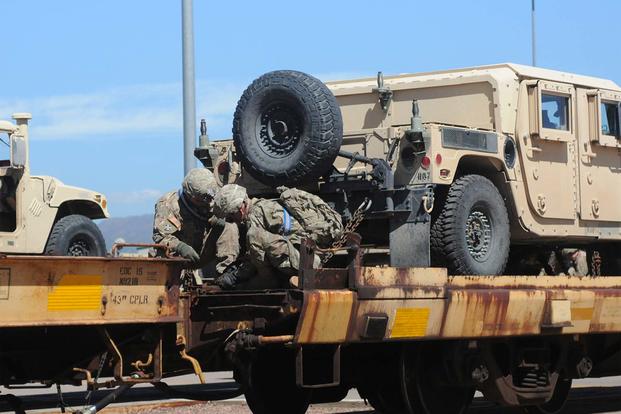The U.S. Army has identified the heavy brigade scheduled to deploy next year to Europe to counter Russian aggression in the region.
The 3rd Armored Brigade Combat Team of the 4th Infantry Division, based at Fort Carson in Colorado, will deploy in mid-January as part of the European Reassurance Initiative, according to Lt. Gen. Ben Hodges, head of U.S. Army in Europe.
"That's based only on when that ship actually arrives," he said Monday during a briefing with reporters at the Association of the United States Army's annual conference in Washington, D.C.
Part of the deployment is designed to determine "how long does it really take us to move," Hodges said. "The choke point won't be how fast we can get off the ship. The choke point, I think, is going to be the rail capacity available to move out of a single port" in Bremerhaven, Germany, he said.
"The next time we do this, next September, we'll look at using multiple ports."
Hodges pushed back that there has been a delay in the effort, but underscored the importance of steady funding to carry out such deployments in response to future contingencies.
"This has been the problem for every service chief and every chairman, every year," he said. "If you don't have budget certainty, it makes it very difficult for people to plan and anticipate, especially when you have to spend that money."
In a separate presentation earlier in the day, Hodges said the gridlock in Congress over the defense budget has been holding up Army plans to boost defenses against Russia in Europe.
"Without ERI, there is no deterrence," he said of the $3.4 billion funding proposed for the ERI effort. "If Congress can't pass a budget, that makes it difficult for us to do what we need to do. It is essential for deterrence."
The White House proposed quadrupling ERI funding to $3.4 billion in the fiscal 2017 defense budget, but the recommendation stalled last week when Congress passed a 10-week stopgap funding measure, called a continuing resolution, to avoid shutting down the government. The CR continued spending at fiscal 2016 levels.
Under a fully funded program, U.S. Army Europe was to have started receiving continuous troop rotations of U.S.-based armored brigade combat teams to the European theater in early 2017, bringing the total Army presence in Europe up to three fully manned Army brigades.
By the end of 2017, program funding would have paid for a continuous presence of three fully equipped Army brigade combat teams -- one armored, one airborne and one Stryker brigade -- as well as one pre-positioned set of combat-ready equipment sufficient to support another armored brigade combat team and division-level enablers in Europe, according to a White House fact sheet.
Ambassador Daniel B. Baer, the U.S. representative to the Organization for Security and Cooperation in Europe, joined the panel discussion with Hodges. He said that the $3.4 billion in ERI funding "makes a difference. Diplomacy alone is rarely the solution" to the challenges posed to NATO and partner nations by the aggressive actions and threats emanating from Moscow.
By its actions in Crimea and Ukraine, Russia has shown that it has little respect for borders, Baer said. The U.S. should still offer engagement with Russian President Vladimir Putin on a "rules-based order" in Europe, but should back up the offer with sanctions and a continuing military buildup to deter aggression, he said.
Lt. Gen. Jorg Vollmer, chief of staff of the German Army, said Russian aggression had forced his nation and NATO to focus again on a threat "we thought was long gone" with the end of the Cold War.
-- Brendan McGarry can be reached at brendan.mcgarry@military.com. Richard Sisk can be reached at richard.sisk@military.com.






























